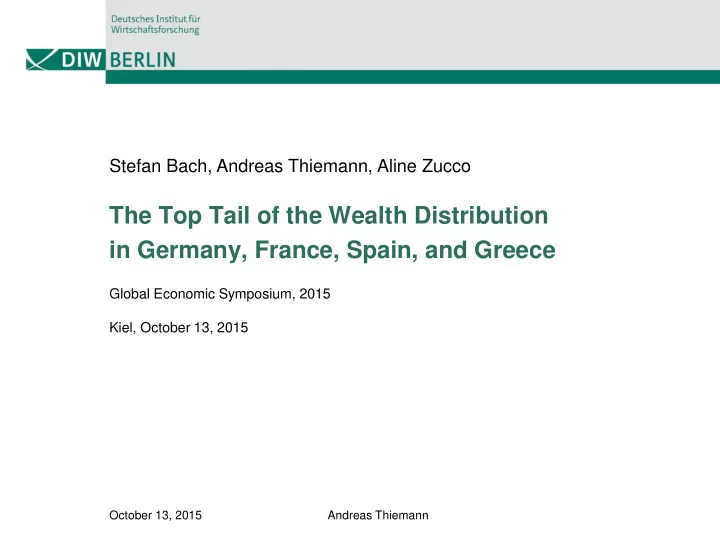

Stefan Bach, Andreas Thiemann, Aline Zucco The Top Tail of the Wealth Distribution in Germany, France, Spain, and Greece Global Economic Symposium, 2015 Kiel, October 13, 2015 1 October 13, 2015 Andreas Thiemann
Outline Background and motivation Data HFCS Forbes and national rich lists Estimation and imputation of the top wealth distribution Results for the adjusted top wealth concentration Discussion Paper: Stefan Bach, Andreas Thiemann, Aline Zucco: The Top Tail of the Wealth Distribution in Germany, France, Spain, and Greece. DIW Berlin Discussion Papers 1502, 2015. October 13, 2015 Andreas Thiemann 2
Background and motivation Rising inequality in income and wealth, in particular at the top Poor information on the top tail of household wealth Household surveys • German Socio-Economic Panel (SOEP), 2002, 2007, 2012 • Household Finance and Consumption Survey (HFCS) 2009-11 • Underrepresentation of top income and wealth – Sampling error (“non observation bias“) – Selectivity (“non response bias“, “middle class bias“) Administrative data • Wealth and estate taxation: Selectivity due to tax rules • Family owned firms, foundations, family offices: Non-disclosure Rich lists of the big fortunes: Forbes World’s billionaires , national rich lists National and financial accounts: macro aggregates Estimation of top wealth concentration in Germany, France, Spain, and Greece Integration of HFCS and rich lists Estimation of Pareto distribution for the top tail • following Vermeulen (2014) Imputation of the missing rich October 13, 2015 Andreas Thiemann 3
October 13, 2015 Andreas Thiemann 4
October 13, 2015 Andreas Thiemann 5
Pareto distribution Good approximation of the top tail of income and wealth Pareto (1896), Kuznetzs (1955), Piketty & Saez (2003) Based on two parameters (Representation in appendix) Minimum wealth and „Pareto - alpha“ Net Household Wealth (HFCS Definition) Total household assets (excluding pension wealth) - Total outstanding household’s liabilities = Household net wealth October 13, 2015 Andreas Thiemann 6
October 13, 2015 Andreas Thiemann 7
October 13, 2015 Andreas Thiemann 8
October 13, 2015 Andreas Thiemann 9
October 13, 2015 Andreas Thiemann 10
October 13, 2015 Andreas Thiemann 11
October 13, 2015 Andreas Thiemann 12
October 13, 2015 Andreas Thiemann 13
October 13, 2015 Andreas Thiemann 14
October 13, 2015 Andreas Thiemann 15
Conclusion Top wealth concentration in Germany, France, Spain, and Greece Underrepresentation in household surveys Integration of the big fortunes from rich lists • broader base of national rich lists compared with Forbes Imputation of the missing rich by Pareto distribution Adjustment substantially increases top wealth concentration Top percentile share increases • from 24 to 33 percent in Germany • from 18 to 21 percent in France • from 15 to 17 percent in Spain • (from 8 to 12 percent in Greece) National rich lists instead of Forbes increase top wealth concentration • especially in France and Spain Research perspectives Data quality: Surveys and rich lists Tax files from wealth taxes, estate taxes, financial statements of firms and foundations Microsimulation analyses of wealth taxation Distribution analyses of household wealth and income October 13, 2015 Andreas Thiemann 16
Thank You for Your Attention! October 13, 2015 Andreas Thiemann 17
Back-up slides October 13, 2015 Andreas Thiemann 18
Pareto distribution Idea and representation Top wealth distribution follows a power-law function • for any wealth w i that exceeds a threshold w min , specified by the Pareto coefficient α Density function 𝛽 𝛽𝑥 𝑛𝑗𝑜 𝛽+1 𝑗𝑔 𝑥 𝑗 ≥ 𝑥 𝑛𝑗𝑜 𝑔 𝑥 𝑗 = 𝑥 𝑗 (1) 0 𝑗𝑔 𝑥 𝑗 < 𝑥 𝑛𝑗𝑜 Distribution function 𝑥 𝑥 𝑛𝑗𝑜 𝑥 𝑗 ) 𝛽 𝑄 𝑋 ≤ 𝑥 𝑗 = 𝐺 𝑥 𝑗 = 𝑔 𝑢 𝑒𝑢 = 1 − ( ; ∀ 𝑥 𝑗 ≥ 𝑥 𝑛𝑗𝑜 (2) 𝑥 𝑛𝑗𝑜 Complementary cumulative distribution function (ccdf) 𝑥 𝑛𝑗𝑜 𝑥 𝑗 ) 𝛽 ; ∀ 𝑥 𝑗 ≥ 𝑥 𝑛𝑗𝑜 𝑄 𝑋 > 𝑥 𝑗 = 1 − 𝑄 𝑋 ≤ 𝑥 𝑗 = ( (3) Interpreted as ranking (“ Zipf's law”, Zipf/zeta distribution) 𝑜 𝑥 𝑗 𝑥 𝑛𝑗𝑜 𝑥 𝑗 ) 𝛽 ; ∀ 𝑥 𝑗 ≥ 𝑥 𝑛𝑗𝑜 ≅ ( (4) 𝑜 𝑜 𝑥 𝑗 𝑥 𝑗 𝑚𝑜 = −𝛽 ln 𝑥 𝑛𝑗𝑜 (5) 𝑜 October 13, 2015 Andreas Thiemann 19
Pareto distribution: Density and distribution function, complementary cumulative distribution function (ccdf) 1.0 α = 2 0.9 F(x) 0.8 0.7 α = 1 1 - F(x) (ccdf) f(x), F(x), 1 - F(x) 0.6 0.5 0.4 0.3 α = 1 0.2 f(x) 0.1 α = 2 0.0 0 0.5 1 1.5 2 2.5 3 3.5 4 4.5 5 Net wealth in million Euro October 13, 2015 Andreas Thiemann 20
October 13, 2015 Andreas Thiemann 21
October 13, 2015 Andreas Thiemann 22
October 13, 2015 Andreas Thiemann 23
Recommend
More recommend